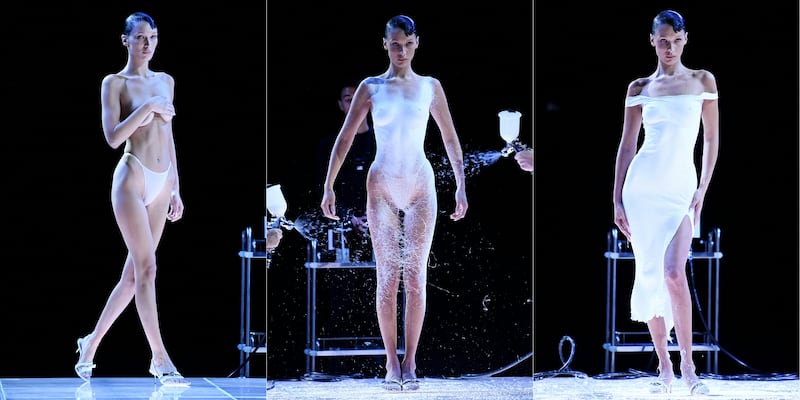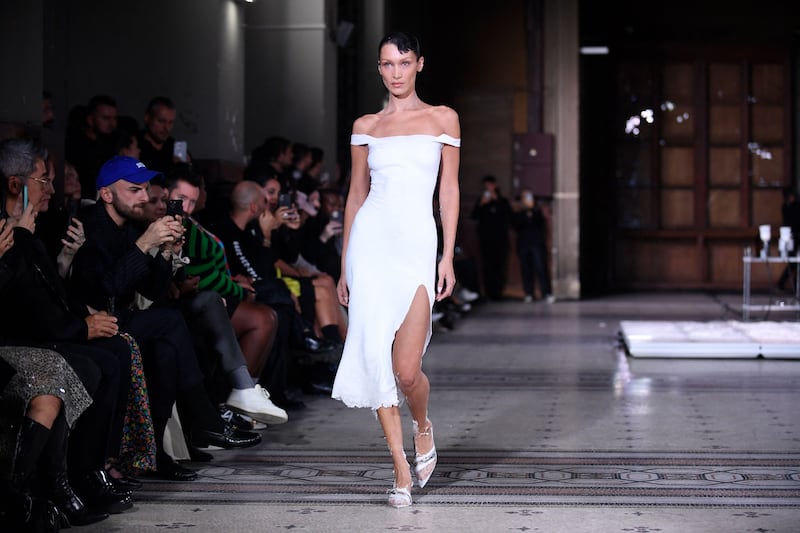There’s a trend on TikTok where posters take a high-fashion look and pose a rhetorical question. “Is this fashion or is she just skinny?”
In the case of Bella Hadid’s viral spray-on dress, the answer from the social-media jury was fairly unanimous. If the dress had been intended as a statement about an industry in which the clothes are sometimes secondary to the alarmingly thin bodies wearing them, it would have been a brilliantly subversive one. Alas, those involved in its execution (because this was not so much an item of clothing as a piece of theatre or a science experiment) seem to have had their tongues nowhere near their cheeks.
At the end of the Coperni show at Paris Fashion Week, the American model — nude except for an itsy-bitsy thong — appeared on stage. For nine minutes the rapt crowd watched as an instant dress was sprayed on to her body. Straps and a slit up the leg were rapidly moulded by hand by a designer from the brand that earlier this year offer a handblown glass bag for sale for €2,700.
“The substance — a patented spray-on fabric developed by a London-based company called Fabrican — looked like spider webs at first, until the fibrous layers thickened, instantly drying into a pebbled fabric and effectively mummifying the model. In pictures the dress looked as if it could be a kind of silk or cotton, but to the touch, it felt soft but elastic, bumpy like a sponge,” the New York Times reported.
READ MORE
It was a high-fashion moment — novel, impressive and futuristic — even if the dress itself was decidedly bland and forgettable, the kind of garment you imagine an avatar in Mark Zuckerberg’s Metaverse might wear to the Oscars.
For those worried about wastefulness in the midst of a climate crisis, there was some good news. The nonwoven fabric can be washed and reworn (by Hadid, or by the small handful of people on the planet with her exact body measurements). Alternatively, it can be put back in its bottle of original solution to regenerate.
‘For three years I would wake up every morning hysterical,’ Hadid told Vogue earlier this year, describing how she was a ‘girl with incredible insecurities, anxiety, depression, body-image issues, eating issues, who hates to be touched, who has intense social anxiety’
What feels distinctly less forward-looking is fashion’s stubborn obsession with extreme thinness.
This isn’t a criticism of Hadid, who has fielded what must be hurtful comments about her low weight since early in her career and is understandably tired of it. She has spoken movingly about suffering from depression, anxiety and Lyme disease. “For three years while I was working, I would wake up every morning hysterical, in tears, alone,” she told Vogue earlier this year, describing how she was a “girl with incredible insecurities, anxiety, depression, body-image issues, eating issues, who hates to be touched, who has intense social anxiety”.

But now aged 25 — as someone the magazine calls “a bona fide supermodel in the full flush of her fame”, with 55.4 million followers on Instagram — she’s not exactly an uninvolved bystander in the promotion of what are, for most people, entirely unrealistic body standards. In fact she’s arguably better placed that most to understand why the attention garnered by the spray-on dress would have reopened the debate about fashion’s veneration of only the tiniest of human bodies.
For a brief few years it looked as though the body-positivity movement might have succeeded in forcing more inclusivity in the industry. The occasional curvier model began appearing on runways, magazine covers and billboards. Brands whose collections stopped at a size 16 or 18 risked justifiable outrage on social media. This winter the preference is for clothing that is decidedly oversized, almost as though big coats and dresses in which to cocoon yourself are the perfect antidote to a tumultuous world; almost as though women have decided they will not apologise for taking up more space.

Not everyone is equally thrilled about these developments. Over the summer the controversial Canadian psychologist Jordan Peterson retweeted a Sports Illustrated cover featuring a plus-size model with the words, “Sorry. Not beautiful. And no amount of authoritarian tolerance is going to change that.”
But along comes a moment like the viral spray-on dress — or, say, Victoria Beckham’s recent admission that she eats the same dinner every day in order to stay thin, or the news that hip-skimming low-rise jeans and microminis are back — and you’re reminded that the size-0 fetish never really went away.
For those of us old enough to have lived through these trends first time around, hip-hugging jeans and microminis belong to the ‘heroin chic’ era of the 1990s, the misogynist nadir of the fashion industry, when catwalks were full of women who looked as if they belonged in hospital
For those of us old enough to have lived through these trends first time around, hip-hugging jeans and microminis belong to the “heroin chic” era of the 1990s, the misogynist nadir of the fashion industry, when catwalks were full of women who, frankly, looked as if they belonged in hospital. At least nobody’s calling it heroin chic now. Even so, the runways at Paris were once again full of the thigh gaps and jutting hipbones that are associated with the era far more indelibly than any of the clothes. At a time when eating disorders and mental-health problems are on the rise among teenagers — fuelled by the pandemic — the thought that we’re going back to that time is a grim prospect.
Fashions come and go, but certain things remain constant. One of them is the industry’s insistence that thinness equals beauty. Another is that for all the shtick about empowerment and celebration, fashion is more often focused on objectifying or commoditising women than helping them to feel good about themselves. How depressingly apt, then, to learn that, at a rehearsal the night before the big event, a model who was acting as the body double for Hadid “couldn’t control her shivering on the already chilly runway, as the even-colder spray-on material hit her skin, and as she breathed in its thick, glue-like odour,” the New York Times reported.
After her own performance, Hadid said: “Honey, cold is an understatement ... I really blacked out.” Still, she added, it was the best day of her life. A better question might be: is this fashion or is she just miserable?
















